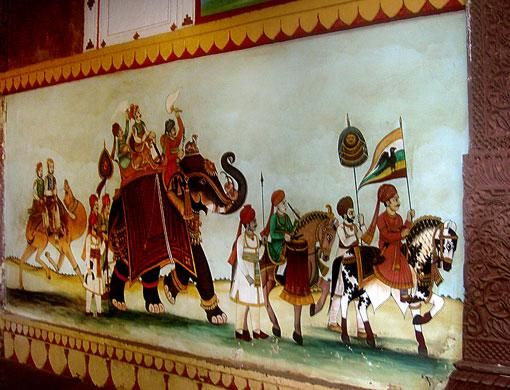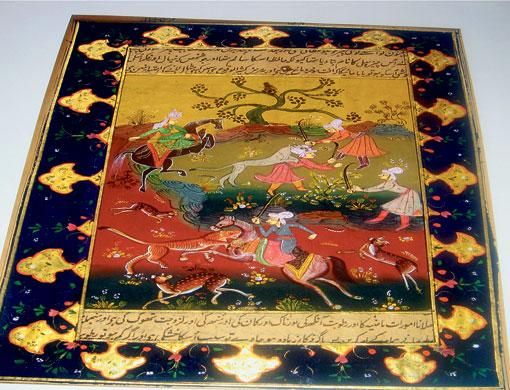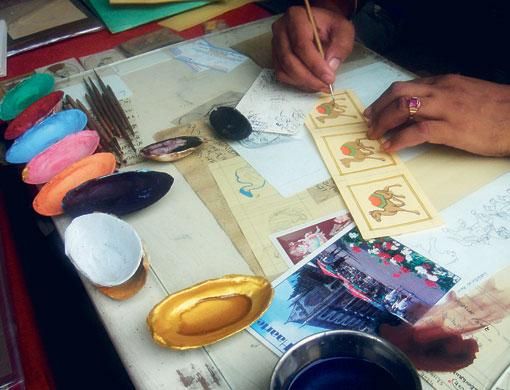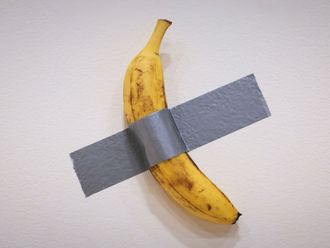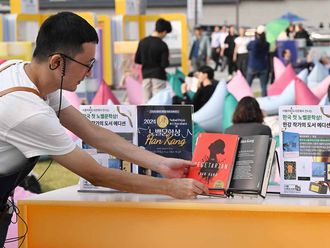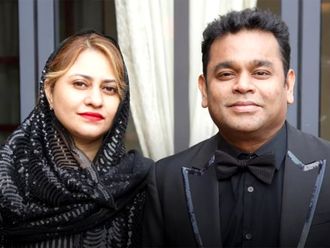In a corner of the Pal Haveli hotel at Jodhpur in the Indian state of Rajasthan, miniature artist Gangaram Kumawat gives finishing touches to a portrait of a Rajasthani woman while his brother, Tajpal, arranges miniature paintings for display. Gangaram and Tajpal are from Samode, located 40 kilometres from Jaipur, the capital of Rajasthan, where their family has been practising the Jaipur school of miniature painting for six generations.
In Jaipur another miniature artist, Babulal Marotia, displays his craft to tourists and dignitaries at the City Palace, the museum and official residence of the Jaipur royal family.
The Kumawat brothers and Marotia represent contemporary Rajasthani miniature artists who continue to preserve and nurture a cultural and historical legacy, albeit in different social circumstances.
Miniature painting developed in western India during the 11th century when artists began illustrating Jain and Buddhist palm-leaf manuscripts. These small-scale paintings were exactingly detailed. Following marital and political alliances between the Jaipur royal family and the Moguls in the 16th century, inter-cultural exchange led to the development of indigenous styles that drew upon elements of Persian miniature painting. This resulted in the Jaipur gharana, or the Jaipur school of miniature painting. The influences spread across the rest of Rajasthan and six other gharanas of miniature painting sprang up - Bikaner, Mewar (Udaipur), Marwar (Jodhpur), Kishangarh, Bundi and Kota. "The Jaipur school, nevertheless, retains the most discernible Mogul influences such as fine detailing, goldwork and understated use of colour," says Marotia, who is the winner of the 1997 National Award and the 2004 Unesco South Asian Seal of Excellence.
Marotia learnt the art by minutely examining and identifying qualities that distinguish the Jaipur school from others, such as the Mogul. "In Mogul works, the men sport straight beards, whereas Rajasthani paintings depict them with curved ones," he says. Faces of subjects in Mogul miniatures are round and their stature short while those in Rajasthani paintings feature big eyes and stature. Furthermore, while the golden borders of Mogul paintings are decorated with creepers and flowers, the ones in the Jaipur paintings are usually plain gold.
Fond of painting as a child, Marotia learnt brushwork from Guru Padam of Jaipur before immersing himself in the world of miniature painting. It was only after five years of studying and practising the craft that Marotia felt he had achieved something substantial. "Miniature painting is primarily about the fineness of detailing and outlining. Colour shading is important but if the original sketch is not good in the first place, all else pales," he says.
Miniature painting used to be patronised by Jaipur's royals and aristocratic families. Nature, scenes from the Hindu epics Ramayana and Mahabharata and the royalty themselves formed the subjects. The paintings produced were brilliant, meticulously detailed depictions of wedding processions of kings, scenes from hunts or the trysts of Lord Krishna and Radha, far removed from the worlds of ordinary folk. The patrons commissioning the works were, therefore, shaping the subjects of the paintings according to their sensibilities. "The artists used to work for the royalty, so they only painted the royalty," Marotia says.
"However, after India's independence, the dissolution of princely states and the abolition of zamindari [land tenancy prevalent since Mogul times], our art suffered as our patrons were no longer able to support us. There were only a few families which had the resources to commission works," Tajpal says. His family continued to paint although there was no outlet for the works to be displayed and sold. The growth of tourism in India, however, greatly altered the situation, creating a new market for their miniature paintings.
According to Marotia, paintings depicting flora and fauna, scenes from Hindu mythology and old-style representations of royals are popular with foreign and Indian buyers. "I like to base my works on the old style," Marotia says. The Kumawat brothers seem to have liberated themselves from the ambit of representing royalty. "Our heads are filled with so many designs (sic) waiting to be captured on paper," Gangaram says.
He brings out a painting that depicts a wedding procession entering the 300-year-old Pal Haveli, which is adorned with carved windows and frescoed walls. A star-studded sky with a crescent moon and parrots perched on fruit-laden trees in the surrounding gardens add to the ambience. "We took five months to create this painting. In fact, we have not even shown it to the haveli owners as we want to gift it to them," Tajpal says.
While miniature paintings were originally made on palm leaves, they are nowadays done on silk or cotton fabric or on handmade paper. An interesting trend which has emerged is of creating miniature paintings on antique handmade paper. "We placed two samples on display [at the palace] and they were appreciated. So we continued the trend," Marotia says. He further accentuates the painting's antique appearance by rubbing the paper with ash obtained from traditional Indian hearths where the cooking fire coats the ceilings and walls with soot.
Tajpal shows a painting of a tiger that his paternal grandfather created on a page of Urdu calligraphy more than 40 years ago. As the Kumawat brothers and Marotia source the paper from waste-paper vendors, the antique paper is saved from destruction and gets a new life as painting.
The miniature paintings are made with colours derived from stone and organic materials. The artists grind stones of different colours, add gum to the powder and leave it for about 20 days.
"For example, if we wish to create pink, we mix red and white stone. We get the red stone from Samode itself," Tajpal says. The Kumawat brothers create black paint by boiling and grinding almond leaves and green is made from guava leaves.
Marotia obtains black from kohl, while blue, white and orange are created from indigo flowers, chalk and vermilion respectively. For goldwork, which is a characteristic of the miniatures, Marotia makes a mixture of honey, gum and gold dust. "We paint with squirrel-hair brushes as they are fine enough for creating details," Marotia adds. A 1 by 1.5 foot painting can take up to two months to make, with the fine detailing of faces, for instance, requiring the longest time.
Tourism has significantly contributed to sustaining the craft, and being situated at tourist vantage points draws further attention to the paintings and the artists. With the artists offering live demonstrations of their work, people become acquainted with them and the process by which the paintings are made. This creates a more intimate engagement with the works many of them purchase.
Marotia's initiation into earning a living from his craft was fraught with challenges. "I would initially sell my works through showrooms but we wouldn't get our share of profits. Our paintings would sometimes remain unsold," he says.
However, when Maharaja Bhawani Singh of the Jaipur royal family invited artisans to demonstrate their crafts at the palace in 1991, Marotia got an opportunity to display his paintings and present live demonstrations of his work. "[Being at the City Palace] has made a huge difference to my life. We directly receive profits and on seeing us work, visitors become aware of how painstaking and meticulous this work is, inspiring better appreciation of the art," he says.
Marotia has introduced his wife, daughter and three brothers to miniature painting. They paint eight months a year at their residence-cum-workshop in Kishanpol Bazaar in the walled city of Jaipur. The remaining months are devoted to selling the works at the City Palace during the peak tourist season from November to February.
The Kumawat brothers' journey from Samode to Pal Haveli began when their family was commissioned to paint frescoes in Samode Palace and a traditional Rajasthani homestead-turned-hotel in Rohetgarh, 40 kilometres from Jodhpur.
The owner of Pal Haveli, Mahesh Karan Singh Rathore, visited Rohetgarh and liked the work of the Kumawat brothers. He invited them to decorate his own haveli with frescoes. They worked at the haveli for more than a year and were asked to stay on to display, sell and hold demonstrations of their work while continuing to work on the haveli. "Tourists are fascinated by the way we paint," Gangaram says, adding that he and Tajpal are happy to be based in the haveli.
The government accords recognition to the artists and sends them on trips abroad, where they exhibit and hold demonstrations of their work. Marotia's first trip abroad was to Paris in 1994.
Owing to his presence at the City Palace, Marotia has had opportunities to meet dignitaries such as the late Benazir Bhutto and Prince Charles, whose portrait he painted on his thumbnail.
The Kumawat brothers and Marotia are intent on ensuring that the art of miniature painting continues to thrive. The Kumawat family has established an art school for children in Samode. "We do not charge fees. We are just happy that the children are learning the craft and thereby keeping it alive," Gangaram says.
Marotia and his brothers have also opened an art school, the Saraswati Kala Kendra, where they hold one-month summer camps for artists between ages 10 and 35. "In the past, women were restrained by the purdah system and were not allowed to paint. But nowadays, 75 per cent of our students are women. Many hail from countries such as Japan, Belgium and Korea," Marotia says. "Most of them are artists themselves and want to enhance and expand their knowledge of art and techniques." Marotia has also taught his daughter to paint.
Marotia's work moved beyond the confines of traditional visual art and metamorphosed into Post-Modern pop art, as it was emblazoned on a wardrobe named Hindistan by Italy-based Turkish furniture designer Onur Mustak Cobanli. "I happened to be researching Indian furniture and arts when I came across Marotia and his work at an event in Milan last year. I liked his paintings very much and decided to use his work on furniture," Mustak wrote in an e-mail. "The contrast between the simplicity of my furniture design and the detailed workmanship of his work impressed many people. Moreover, it also proved that the traditional and the modern - and that too of two different cultures - can mix."
Just as miniature paintings have adapted themselves to the contemporary milieu, the artists, too, embrace the contemporary while keeping themselves firmly planted in their historical traditions.
Priyanka Sacheti is an independent writer based in Muscat.


